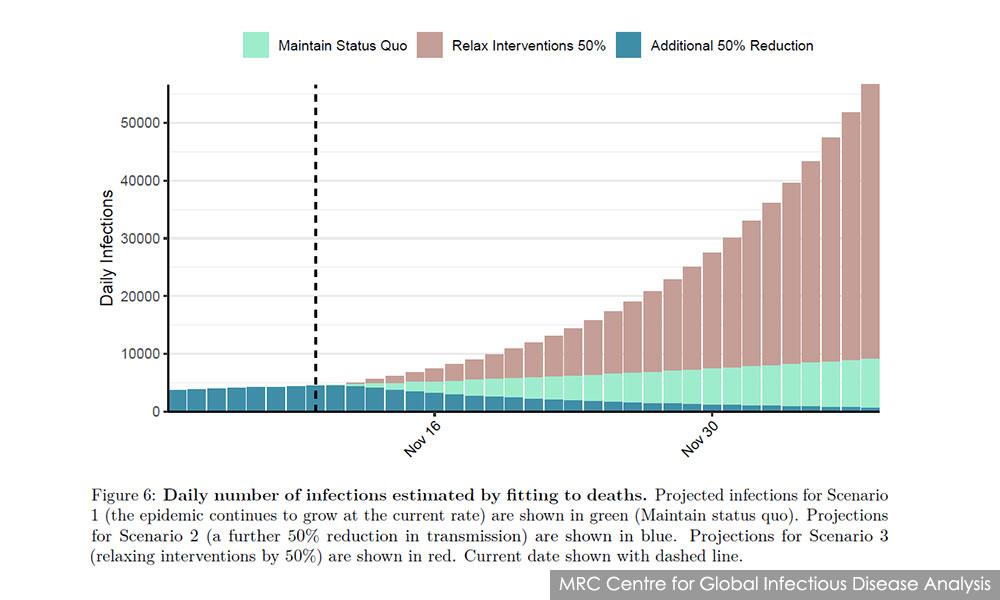Modelling suggests Covid-19 cases to rise steadily unless more is done
COVID-19 | The number of Covid-19 cases in Malaysia is expected to rise steadily over the next four weeks unless stronger interventions are introduced to curtail its spread, according to projections by Imperial College London’s MRC Centre for Global Infectious Disease Analysis.
Its model estimated that the number of Covid-19 infections in Malaysia is projected to increase steadily to about 7,467 infections per day by Dec 8 if no new measures are introduced to curb its spread. It also projected there would be about 16 Covid-19 deaths per day.
This is an increase from the model’s estimate of 4,413 infections per day as of Nov 10. The figure is vastly different from the official tally of 869 confirmed cases that day due to the model’s particular approach to account for underreporting of Covid-19 cases.
The model also forecasted that if public health interventions are strengthened such that Covid-19 transmission is slashed in half, then the daily number of infections would drop to 647 by Dec 8 – a reduction of about 91.3 percent compared to the status quo.
Conversely, if the interventions are relaxed such that Covid-19 transmission is increased by 50 percent, the model projected an exponential increase in daily infections to 56,074 cases per day by Dec 8.

The report stated that these figures should not be viewed as predictions, but can help policymakers understand the total number of Covid-19 infections in their country, healthcare demand in the near future, and the impact for their public health interventions.
“Here we aim to provide each country with an indication of where they are in their epidemic and scenarios of how healthcare demand is likely to vary over the next 28 days.
“Changes in transmission from today will also shape the next 28 days so these estimates should not be viewed as predictions but scenarios to help countries understand how strategies today are likely to shape the next phase of the epidemic,” it said.
The latest instalment of Imperial College’s weekly situation report comes as Malaysia’s National Security Council relaxed certain conditional movement control order (CMCO) restrictions such as by reopening childcare centres and allowing up to three people of the same household to travel in the same car.
It also resisted calls to impose tighter travel restrictions, while its work-from-home mandate is limited to managers and supervisors in “formal sectors” under the International Trade and Industry Ministry’s purview and certain civil servants.
In the wake of rising cases, the government has imposed CMCO for most parts of the country until Dec 6.
Asymptomatic cases
Meanwhile, the Imperial College London researchers also estimated there had been about 91,595 Covid-19 infections over the past four weeks prior to the report’s date of Nov 10. The official tally of confirmed cases for the corresponding period was 25,170 cases, including imported cases.
“A significant proportion of infections are likely to be either completely asymptomatic, or sufficiently mild as to not seek care. From our early analysis of data from China, we estimate this to be approximately 40 to 50 percent of all infections.
“Of those infections that are symptomatic and would seek care, the surveillance underway in each country is likely to pick up a fraction of these.
“In countries that are testing widely in the community, we would expect this fraction to be much higher than in countries that are focusing testing in hospitals.
“The difference in the estimated infections and reported cases should be interpreted with this in mind; however, the scale gives a sense of the likely potential for ongoing transmission in the community,” the report cautioned in its “frequently asked questions” section.

The model’s calculations are not based on the amount of testing being conducted in a country nor the number of confirmed Covid-19 cases reported.
Instead, it relies on the official tally of Covid-19 deaths on basis that these are less likely to be underreported. The figure is used to infer infection trends for the time period when the deceased had likely acquired the infection uses this information to make projections.
The model also uses anonymised mobile phone location tracking data to measure population mobility, which it uses to infer the extent of health authorities’ public health interventions.
It also estimated that Covid-19’s effective reproduction number (Rt or Reff) in Malaysia is around 1.16 as of Nov 10.
The official figure according to the Health Ministry’s website was 1.05 on that day, meaning that on average, every 100 Covid-19 patient was passing the disease onto 105 others over the course of their illness, thus fuelling the growth of the outbreak.
The MOH estimate the figure yesterday was 0.95, which indicates an outbreak that is slowly losing steam rather than accelerating.
On Nov 4, Health Ministry director-general Dr Noor Hisham Abdullah had said that that the ministry is confident in “flattening the curve” and reduce Covid-19’s reproduction number to 0.5 within three weeks. - Mkini
✍ Credit given to the original owner of this post : ☕ Malaysians Must Know the TRUTH
🌐 Hit This Link To Find Out More On Their Articles...🏄🏻♀️ Enjoy Surfing!




















Post a Comment